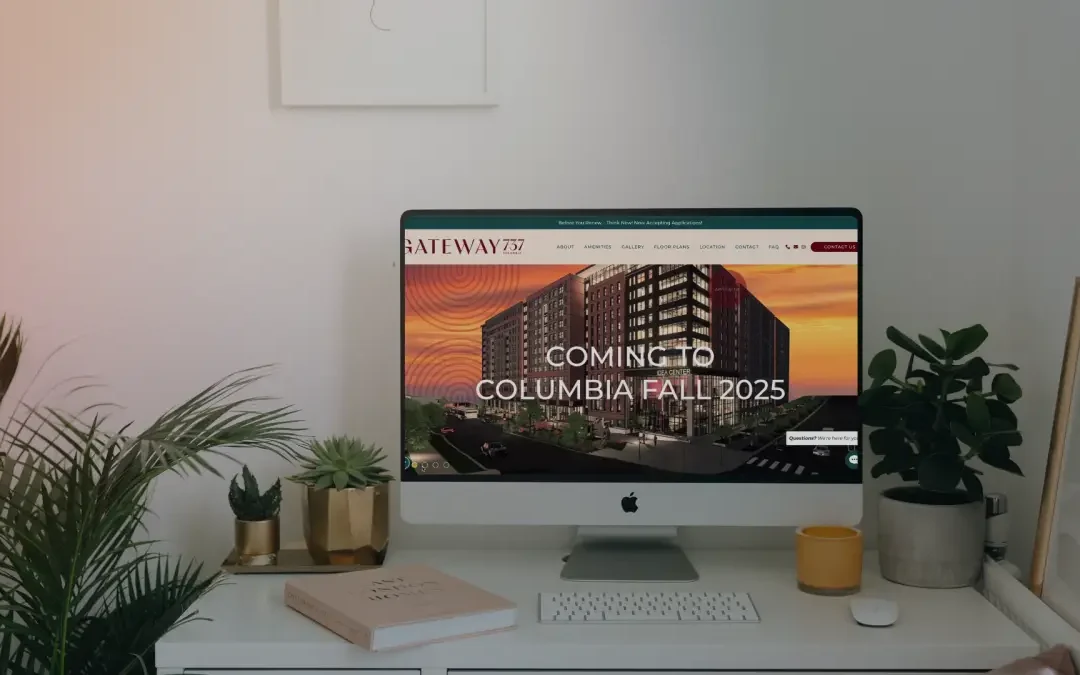
by threshold | Jun 23, 2025 | All, Culture, Digital Marketing, Marketing
Unlock the Power of Continuous Refinement for Better ROI
In today’s hyper-competitive digital landscape, especially within real estate marketing or bank or credit union marketing, launching a campaign is no longer the finish line—it’s the starting point. Running your ad, sending that email blast, or publishing your post might get you in the game, but optimization is what keeps you winning.
So, if your campaigns aren’t performing like you hoped—or you’re just not sure what’s working anymore—it’s time to stop guessing and start refining.
At Threshold, we believe that great marketing isn’t built overnight. It’s built through ongoing strategy, testing, and precision improvements that maximize every click, view, and conversion.
Whether you’re marketing a new apartment lease-up or launching a seasonal campaign for a bank or credit union, these insights will help you drive more meaningful results.
Why Is Optimization So Important?
1. Campaigns Lose Steam Over Time
Ad fatigue, content blindness, and changing audience behavior can drag your metrics down. Optimization breathes new life into your campaigns by adjusting creatives, CTAs, targeting, and more.
In real estate marketing, static visuals can become invisible to renters. In bank and credit union marketing, rates and products change frequently. Your messaging needs to evolve with them.
2. The Data Is Talking—Are You Listening?
Analytics give you clues. Are people bouncing? Not clicking? Not converting? With continuous refinement, you can pivot fast and save both time and budget.
3. Platforms Reward Performance
Whether it’s Meta Ads or Google Search, platforms favor optimized content. Lower CPCs, higher quality scores, and better placement all come from well-tuned campaigns.
Real Results from Real Refinement
Threshold helped one real estate client cut their Meta Ads budget in half—just by optimizing content and introducing high-quality video ads.
We don’t just launch—we iterate, test, and elevate until every campaign performs like a well-oiled machine.
Optimization Is Not Optional—It’s Strategic
Here’s what continuous optimization can help you achieve:
⭕️ Higher engagement rates
⭕️ Better ROI per campaign
⭕️ Deeper insights into your audience
⭕️ Reduced waste on ad spend
⭕️ Improved brand trust and visibility
💡 “What gets measured gets managed—and what gets managed gets results.”
🎯 Final Thoughts
Optimization is the difference between running a campaign and running it well. Don’t just hit “publish” and hope for the best. Test, track, and tweak. Better performance is always within reach—and we’re here to help you get there.
Ready to stop wasting ad dollars and start seeing results? Whether you’re in real estate or financial services, our team will tailor an optimization strategy that meets your goals. Let Threshold help you create a roadmap for success – schedule a consultation today.

by threshold | Jun 10, 2025 | All, Culture, Digital Marketing, Marketing
A Practical Guide to Boosting Engagement, Conversions, and ROI
Let’s face it—modern marketing can feel like juggling flaming swords while riding a unicycle. With campaigns spread across Instagram, email inboxes, Google Ads, and SEO strategies, it’s easy to feel stretched thin and wonder, “Is this even working?” The truth is, you don’t need a full campaign overhaul to see better results. Sometimes, it’s just about fine-tuning what you’re already doing. Here are 10 quick, actionable tips to help you optimize your real estate marketing or bank and credit union marketing campaigns across all major channels—and actually see the ROI you’ve been chasing.
1. Audit Before You Act
Before jumping into changes, take stock of what’s already working. Use tools like Google Analytics, Meta Business Suite, or your email platform’s dashboard to spot underperforming content and campaigns. Why fix what’s not broken?
2. Sharpen Your Social Media Strategy
A clear, consistent social media strategy is essential for increasing engagement and building brand awareness. Create a content calendar, recycle high-performing posts as Stories or Reels, and focus on generating conversations—not just impressions. Pro Tip: Ask a question in your caption—comments are gold for reach.
📌 SEO Tip: Include keywords as hashtags in your organic social media content strategy to boost discoverability.
3. Use Emojis (Strategically) in Emails
Adding emojis to subject lines can increase email open rates—but relevance is key. 🎯 A simple test: if it doesn’t make the message clearer, skip it.
💡 Quick Win: A/B test two subject lines—one with an emoji and one without. You’ll know fast what works for your audience.
4. Segment Like a Pro
Stop sending the same email to everyone. Segment your list by behavior, location, or purchase history to increase open and click-through rates. Personalized campaigns convert 6x better.
5. Refresh Your Paid Ad Creatives Monthly
Ad fatigue is real. Rotate your creatives every 30 days—new visuals, fresh CTAs, and updated copy. Even a color change can boost engagement by 20%.
6. Retarget Like a Pro
Don’t waste your budget retargeting everyone. Focus on high-intent users like landing page visitors or people who watched 75% of your video ad.
7. Write Content That Ranks and Converts
Your content should work double duty—ranking on Google and guiding readers toward action. Use tools like SEMrush to find high-volume keywords, write naturally around them, and always include a call-to-action.
8. Use the Rule of One
In every campaign, focus on one message, one goal, and one CTA. Clarity wins. Confused audiences don’t convert—they bounce.
9. Track Micro-Metrics That Matter
Don’t just watch conversions. Pay attention to scroll depth, video watch time, CTA clicks, and social shares. These micro-metrics tell you what’s resonating.
10. Optimize for Mobile First
More than half of all web traffic comes from mobile devices. If your emails, ads, or website aren’t mobile-friendly, you’re losing both traffic and trust.
📱 Tip: Run a quick check on Google’s Mobile-Friendly Test and prioritize responsive design.
Ready to See Real Results?
Small tweaks can lead to massive improvements. Don’t wait for a total rebrand—start with these tips and test, test, test.
Want to ensure your real estate marketing or bank or credit union marketing strategy is optimized for 2025? Let Threshold help you create a roadmap for success – schedule a consultation to craft a strategy

by threshold | Mar 8, 2025 | All, Culture, Design, Digital Marketing, General, Marketing, Tech/Web
 Ava Page-Arnold
Ava Page-Arnold
When Holder Properties set out to develop Gateway 737, a brand-new off-campus student housing community serving the University of South Carolina, they had the location, the vision, and the team—but no brand identity. That’s where Threshold stepped in.
the challenge: no brand, no presence, no problem.
Unlike established student housing communities with years of branding, reputation, and renewal leases to rely on, Gateway 737 was starting from scratch. The development needed more than just marketing; it needed an entire brand identity that would capture attention, build excitement, and drive pre-leasing momentum well before opening its doors.
our strategy: crafting a brand students couldn’t ignore.
To make Gateway 737 a standout in the highly competitive USC student housing market, we built the brand from the ground up with: → a bold, youthful identity – We created a name, logo, and vibrant color palette that resonated with USC students, reflecting their lifestyle and aspirations. → a high-converting digital presence – We launched a landing page early to capture leads and later built a dynamic website with engaging visuals, interactive elements, and conversion-driven design. → engaging marketing collateral – From brochures to banners and even transforming a construction trailer into a leasing lounge, we ensured every touchpoint reinforced the Gateway 737 brand. → a buzz-driven leasing approach – Instead of relying solely on paid advertising, we leaned into word-of-mouth marketing, on-site activations, and brand storytelling to generate organic excitement and demand.
the results: a leasing win for the record books.
The response to Gateway 737’s brand and marketing strategy was nothing short of remarkable:
→ 250+ leases signed in the first month (27.5% leased)
→ 115 leases signed in a single week
→ 90% leased within four months (Sept–Dec 2024)
→ 100% leased by first week of March 2025
Despite being a brand-new property with zero renewals, Gateway 737 quickly climbed the ranks to become one of the market leaders in pre-leasing numbers—a testament to the power of strong branding and strategic leasing execution.
why it worked: the gateway 737 formula for success.
What made Gateway 737’s brand and leasing strategy so effective? It all came down to:
→ a strong brand identity that made an instant impact
→ a digital experience designed for conversion
→ marketing that met students where they were—on campus and online
→ a leasing strategy focused on engagement over pure advertising spend
final thoughts.
The success of Gateway 737 proves that with the right branding and marketing strategy, even a brand-new student housing community can dominate the leasing game. Looking to replicate this success for your next student housing development? Let’s chat.

by threshold | Feb 24, 2025 | All, Culture, Digital Marketing, Financial Marketing, General, Marketing
 Ava Page-Arnold
Ava Page-Arnold
how financial institutions can use content to build trust and drive engagement.
In an industry built on trust and credibility, financial institutions can no longer afford to overlook content marketing. Today’s consumers don’t just want products and services—they want education, guidance, and reassurance before making financial decisions. That’s where a strong content marketing strategy comes in.
At Threshold, we specialize in financial institution marketing, helping banks, credit unions, and fintech companies create strategic, high-performing content that builds trust, strengthens customer relationships, and drives business growth. With years of experience in the industry, we understand the unique challenges financial brands face, from compliance regulations to evolving consumer expectations.
In this guide, we’ll break down the best practices for content marketing in the financial sector, ensuring your institution stands out, engages your audience, and builds long-term customer loyalty.
why content marketing is essential for financial institutions.
The days of traditional banking ads and impersonal marketing are over. Today’s consumers expect educational, relevant, and accessible financial content. A well-crafted content strategy can:
⭕️ Position your brand as a trusted financial authority
⭕️ Educate customers on complex financial topics
⭕️ Increase website traffic and improve SEO rankings
⭕️ Nurture leads and improve conversion rates
⭕️ Enhance customer retention through ongoing engagement
Simply put, content marketing bridges the gap between your expertise and your audience’s needs.
best practices for financial content marketing
focus on education, not just promotion.
Consumers don’t want a sales pitch—they want clear, actionable financial advice. The most successful financial brands prioritize education over direct selling, offering value first and building trust before ever making an offer.
⭕️ how to do it right:
- Write blog posts that break down complex financial topics (e.g., “How to Improve Your Credit Score in 6 Months”).
- Create financial planning guides, checklists, and explainer videos.
- Use real-life examples and case studies to illustrate financial principles.
example: Instead of just promoting mortgage rates, publish a guide titled “Buying Your First Home: A Step-by-Step Financial Checklist.” This positions your brand as a helpful resource rather than just a service provider.
optimize for search (SEO) to reach the right audience.
Your content won’t drive results if no one can find it. SEO (Search Engine Optimization) is crucial for ensuring your financial content ranks high in search results and reaches the right audience.
⭕️ SEO strategies for financial content:
- Conduct keyword research to find high-intent search terms (e.g., “best retirement savings strategies”).
- Optimize blog titles, meta descriptions, and headings with relevant keywords.
- Use FAQ pages and schema markup to improve visibility in Google’s featured snippets.
- Regularly update older content to keep it fresh, relevant, and SEO-friendly.
example: A credit union writing about personal loans should optimize content for long-tail keywords like “best personal loan options for home renovation” instead of just “personal loans.”
build trust with customer stories and testimonials.
Financial decisions carry high stakes, and consumers need reassurance before choosing a provider. Sharing real customer experiences can add authenticity and credibility to your marketing efforts.
⭕️ how to leverage customer stories:
- Publish success stories showing how your institution helped customers reach their financial goals.
- Create video testimonials featuring real clients discussing their positive experiences.
- Showcase real data and case studies to back up your claims.
example: A small business owner sharing their journey of securing a loan through your institution can resonate more powerfully than a generic product page listing loan rates.
personalize content for different customer segments.
Not all financial customers have the same needs. A first-time homebuyer requires different advice than a retiree planning for their next chapter. Personalized content ensures your messaging is relevant and impactful for every audience segment.
⭕️ ways to personalize financial content:
- Segment email newsletters based on customer demographics and interests.
- Offer interactive tools like mortgage calculators, savings planners, or financial health assessments.
- Create industry-specific content (e.g., financial planning for small business owners vs. individual investors).
example: Instead of a generic blog about credit cards, create separate guides:
✔ “Best Credit Cards for College Students”
✔ “How to Use a Business Credit Card for Cash Flow Management”
use a multi-channel approach.
Consumers engage with financial content in multiple ways—some prefer reading blogs, others engage with social media, and some prefer watching short videos. Your content strategy should span multiple platforms to maximize reach and engagement.
⭕️ how to diversify your content:
- Blog Articles: Write in-depth, SEO-optimized content on trending financial topics.
- Short-Form Videos: Share quick financial tips on Instagram Reels, TikTok, and YouTube Shorts.
- Webinars & Podcasts: Host Q&A sessions with financial experts.
- Infographics & Carousels: Create visually engaging explainers for social media.
example: A personal finance company could write a blog on “5 Budgeting Tips for Families”, then turn the key takeaways into a 30-second Instagram Reel and a LinkedIn carousel post.
to wrap things up.
Financial institutions that embrace content marketing as a long-term strategy will gain a competitive edge, build stronger customer relationships, and establish themselves as industry leaders. By prioritizing educational content, SEO best practices, personalization, and multi-channel engagement, financial brands can create lasting connections with their audience.
Ready to elevate your content marketing strategy? Let’s get you started.

by threshold | Feb 10, 2025 | All, Culture, Digital Marketing, General, Marketing, Tech/Web
 Ava Page-Arnold
Ava Page-Arnold
You can create the most valuable, engaging content in your industry, but if no one can find it, does it really matter? That’s where SEO (Search Engine Optimization) comes in. A strong SEO strategy ensures your content reaches the right audience at the right time, increasing visibility, engagement, and conversions.
Many businesses treat SEO and content marketing as separate strategies when, in reality, they should work together. SEO helps content get discovered, while great content improves SEO rankings. In 2025, search engines continue to prioritize high-quality, user-focused content. That means a well-rounded SEO approach is no longer optional—it’s essential for long-term digital marketing success.
SEO helps your content get discovered.
One of the biggest challenges businesses face is producing content that never gains traction. Without SEO, even the most insightful blog post can get buried in search results, making it nearly impossible for potential customers to find. Search engines rely on factors like keyword relevance, content structure, and internal linking to determine rankings. If your content isn’t optimized, it simply won’t reach its intended audience.
To improve discoverability, businesses should invest in keyword research before creating content. Tools like Google Keyword Planner, SEMrush, and Ahrefs can help identify the terms and phrases potential customers are searching for. Incorporating these keywords naturally into titles, headings, and body copy increases the chances of ranking higher on search engine results pages (SERPs). Additionally, structuring content with clear headings, meta descriptions, and internal links can improve visibility and enhance user experience.
For example, instead of writing a broad blog post titled “How to Improve Your Website,” optimizing it for a high-intent search term like “10 Ways to Improve Website Performance in 2025” will attract a more targeted audience actively looking for solutions.
SEO enhances user experience and engagement.
Ranking high in search results is only part of the equation. Once users land on your website, their experience determines whether they stay, engage, and convert – or bounce immediately. Google factors user experience (UX) into its ranking algorithm, meaning slow, cluttered, or confusing websites are less likely to perform well in search results.
To keep visitors engaged, content should be formatted for easy readability. Short paragraphs, clear subheadings, and bullet points make information digestible, especially for mobile users. Since over 58% of global web traffic now comes from mobile devices, ensuring mobile-friendly design is crucial. A fast-loading site is equally important—pages should load in under two seconds to minimize bounce rates and improve rankings.
Beyond technical optimizations, content should also align with user intent. If someone searches for “Best SEO Strategies for Small Businesses,” they expect clear, actionable insights—not a sales pitch. Providing valuable, informative content that answers real questions builds trust and encourages visitors to explore your website further.
SEO and content build long-term authority.
Establishing authority in your industry takes time, but content marketing combined with SEO can accelerate the process. Google prioritizes high-quality, in-depth content that provides real value to users. That means businesses that consistently publish well-researched, informative content are more likely to rank higher than those pushing out low-quality or promotional material.
One of the best ways to build authority is through long-form content. Studies show that articles exceeding 2,000 words tend to rank higher because they provide comprehensive information on a topic. However, length alone isn’t enough—content must be well-structured, engaging, and supplemented with credible sources.
Another key factor in establishing authority is backlinking. When reputable websites link to your content, it signals to search engines that your site is a trusted source of information. Businesses can improve their backlink strategy by guest posting on industry blogs, producing original research, or creating shareable content like infographics and case studies.
Updating old content is another often-overlooked tactic. Google favors fresh content, so revisiting older blog posts and refreshing them with new statistics, updated insights, and additional internal links can improve rankings and maintain relevance.
SEO helps convert traffic into leads.
Driving traffic to your website is important, but without a clear conversion strategy, those visitors won’t turn into leads or customers. SEO isn’t just about bringing people to your site—it’s about guiding them toward a specific action, whether it’s signing up for a newsletter, downloading a resource, or making a purchase.
A well-optimized content strategy includes strong Calls-to-Action (CTAs) that encourage visitors to take the next step. For example, a blog titled “Best Marketing Strategies for 2025” could include a CTA offering a free downloadable marketing checklist in exchange for an email address. This approach not only provides value to the reader but also helps businesses generate leads.
Another important aspect of conversion-driven SEO is optimizing content for featured snippets. These are the answer boxes that appear at the top of Google search results, often displaying concise responses to user queries. Structuring content with clear headings, numbered lists, and concise answers increases the chances of earning a featured snippet, which can significantly boost click-through rates.
the role of local SEO in content strategy.
For businesses with physical locations or those serving specific geographic areas, local SEO plays a crucial role in content visibility. Nearly 46% of all Google searches are local, meaning businesses that fail to optimize for location-based searches miss out on potential customers.
Optimizing a Google Business Profile is one of the most effective ways to improve local search visibility. Keeping business hours, contact information, and customer reviews up to date increases credibility and helps businesses appear in Google’s Local Pack.
Location-based content is another valuable strategy. Blog posts that target region-specific keywords – such as “Best Mortgage Lenders in Austin” instead of “Best Mortgage Lenders” – help businesses rank higher for relevant local searches. Publishing content tailored to specific communities or industries can also attract a more engaged audience.
AI and voice search optimization are changing SEO.
The rise of AI-powered search and voice assistants like Siri, Alexa, and Google Assistant is changing how people find content. By 2025, nearly 50% of searches are expected to be voice-based, meaning businesses must optimize their content for conversational queries.
Traditional keyword strategies often focus on short, static phrases, but voice search queries tend to be longer and more natural. Instead of optimizing for “SEO tips,” businesses should target “What are the best SEO tips for beginners?” to better align with how people speak.
Structured data markup is another way to optimize for AI search. This coding technique helps search engines better understand website content, increasing the chances of appearing in rich results like knowledge panels and featured snippets.
to wrap things up.
SEO and content marketing aren’t separate strategies—they are two sides of the same coin. Without SEO, content remains undiscovered. Without high-quality content, SEO efforts fall flat. Integrating SEO best practices into your content strategy ensures that your website not only ranks higher but also provides meaningful, valuable experiences for users.
By prioritizing keyword research, optimizing for user experience, and creating authoritative content, businesses can attract the right audience, build long-term credibility, and drive real business results.
Want to ensure your content strategy is SEO-optimized for 2025? Let Threshold help you create a roadmap for success – schedule a consultation to craft a strategy tailored to your business today.

by threshold | Feb 1, 2025 | All, Culture, Digital Marketing, General, Marketing
 Ava Page-Arnold
Ava Page-Arnold
avoid these common content pitfalls & build a strategy that works.
Content marketing is one of the most powerful tools in digital strategy, but simply creating content isn’t enough – it needs to be strategic, consistent, and optimized for results. Many businesses invest in content marketing yet fail to see real returns because they unknowingly fall into common content strategy traps.
If your content isn’t driving traffic, engagement, or conversions, don’t worry – you’re not alone. Here are the top five content strategy mistakes businesses make (and how to fix them in 2025).
inconsistent messaging across platforms.
Your website says one thing, your social media posts say another, and your emails sound completely different. This inconsistency confuses your audience and weakens your brand identity.
the fix
- Develop brand voice guidelines to ensure a consistent tone, style, and messaging across all platforms.
- Align your website, blogs, emails, and social content to tell a cohesive story about your brand.
- Ensure visual consistency by using the same logos, fonts, and color schemes throughout your content.
Example: A brand with a fun and casual tone shouldn’t have dry, corporate-sounding website copy. Keep your brand voice uniform, whether you’re posting on LinkedIn or sending a promotional email.
ignoring keyword research & SEO.
Many businesses write content without considering SEO, which means they’re not targeting the right audience or ranking in search engines. Without keyword research, your content may never reach the people searching for it.
the fix
- Use SEO tools like Google Keyword Planner, SEMrush, or Ahrefs to identify high-ranking, relevant keywords.
- Focus on long-tail keywords that match user intent (e.g., “best social media strategy for small businesses” instead of just “social media strategy”).
- Naturally incorporate keywords into titles, meta descriptions, headers, and body content to improve search visibility.
Example: If you’re a marketing agency, writing about “content marketing strategies” is too broad. Instead, target “content marketing strategies for real estate” to capture a more specific audience.
creating content without a clear goal.
Many businesses produce blogs, social media posts, and videos just for the sake of posting without a clear goal. Without purpose, your content lacks direction and measurable success.
the fix
- Set a clear objective for every piece of content: Is it meant to educate, generate leads, or convert?
- Use analytics to track key performance indicators (KPIs) like traffic, engagement, and conversions.
- Align your content strategy with the buyer’s journey, ensuring you have content for awareness, consideration, and decision-making stages.
Example: A blog post should be optimized for SEO and drive organic traffic, while an email campaign should nurture leads toward a purchase.
not repurposing & maximizing content.
Many businesses publish content once and forget about it instead of repurposing it across multiple platforms for maximum reach.
the fix
Turn a single blog post into:
- A LinkedIn article
- A Twitter thread
- A short-form video for Instagram Reels or TikTok
- A lead magnet in an email campaign
- Refresh and update older content with new data, keywords, and insights instead of creating everything from scratch.
Example: If you publish a blog about “Top Marketing Trends for 2025,” create an infographic summarizing key takeaways and share it across LinkedIn, Instagram, and Pinterest.
forgetting to optimize for user experience (UX).
A great piece of content won’t perform well if it’s hard to read, poorly structured, or slow to load.
the fix
- Use short paragraphs, headers, bullet points, and bold text to improve readability.
- Optimize images and compress files to improve site speed (Google prioritizes fast-loading pages).
- Ensure content is mobile-friendly, as over 58% of web traffic comes from mobile users.
Example: If your blog is a wall of text, visitors will bounce quickly. Break up content with engaging subheadings, graphics, and clear CTAs (Calls-to-Action).
to wrap things up.
Content marketing isn’t just about producing content – it’s about producing the right content with a clear strategy.
By fixing these five common mistakes, you can create consistent, engaging, and SEO-friendly content that drives real business results.




 Ava Page-Arnold
Ava Page-Arnold

